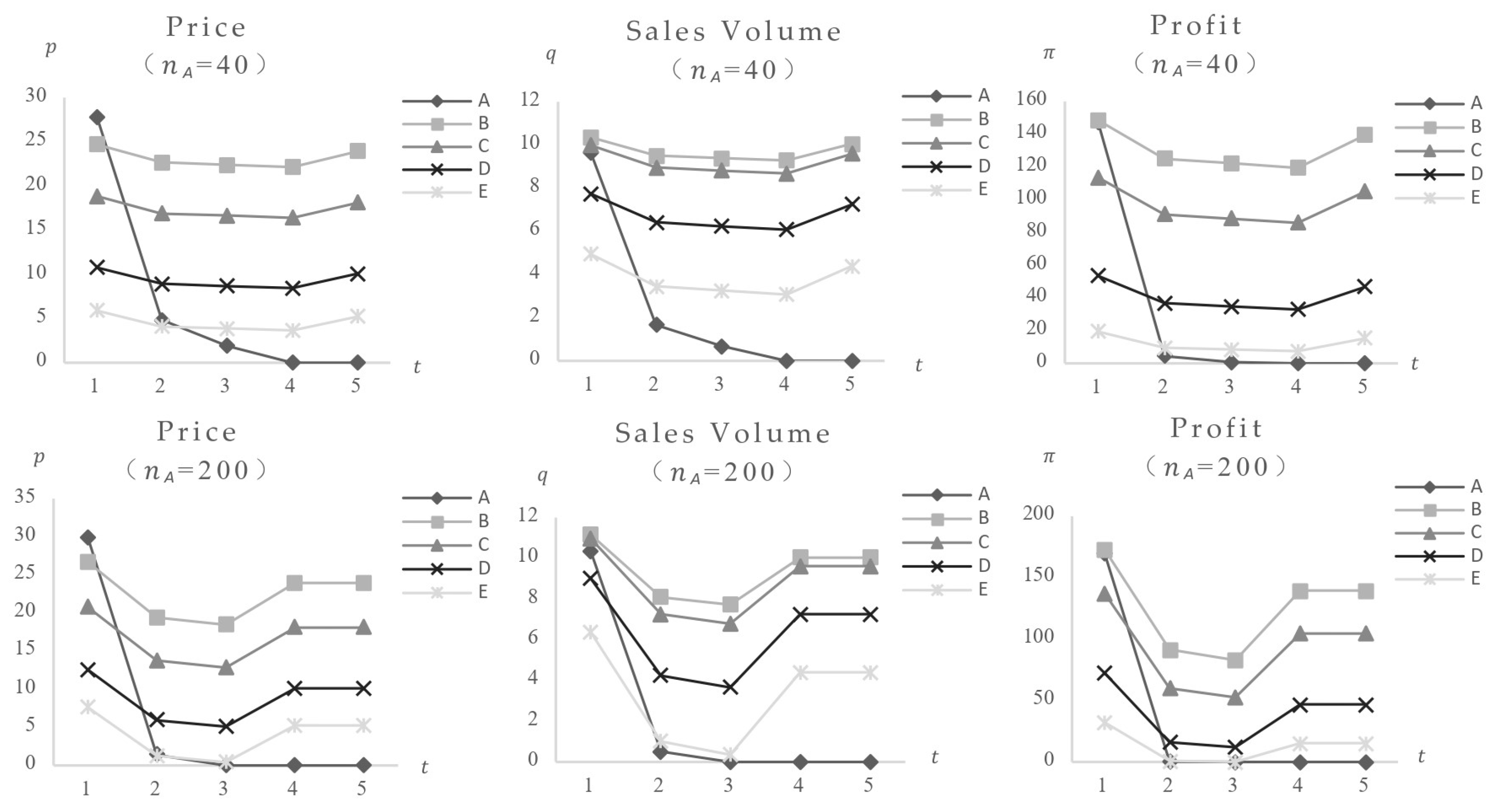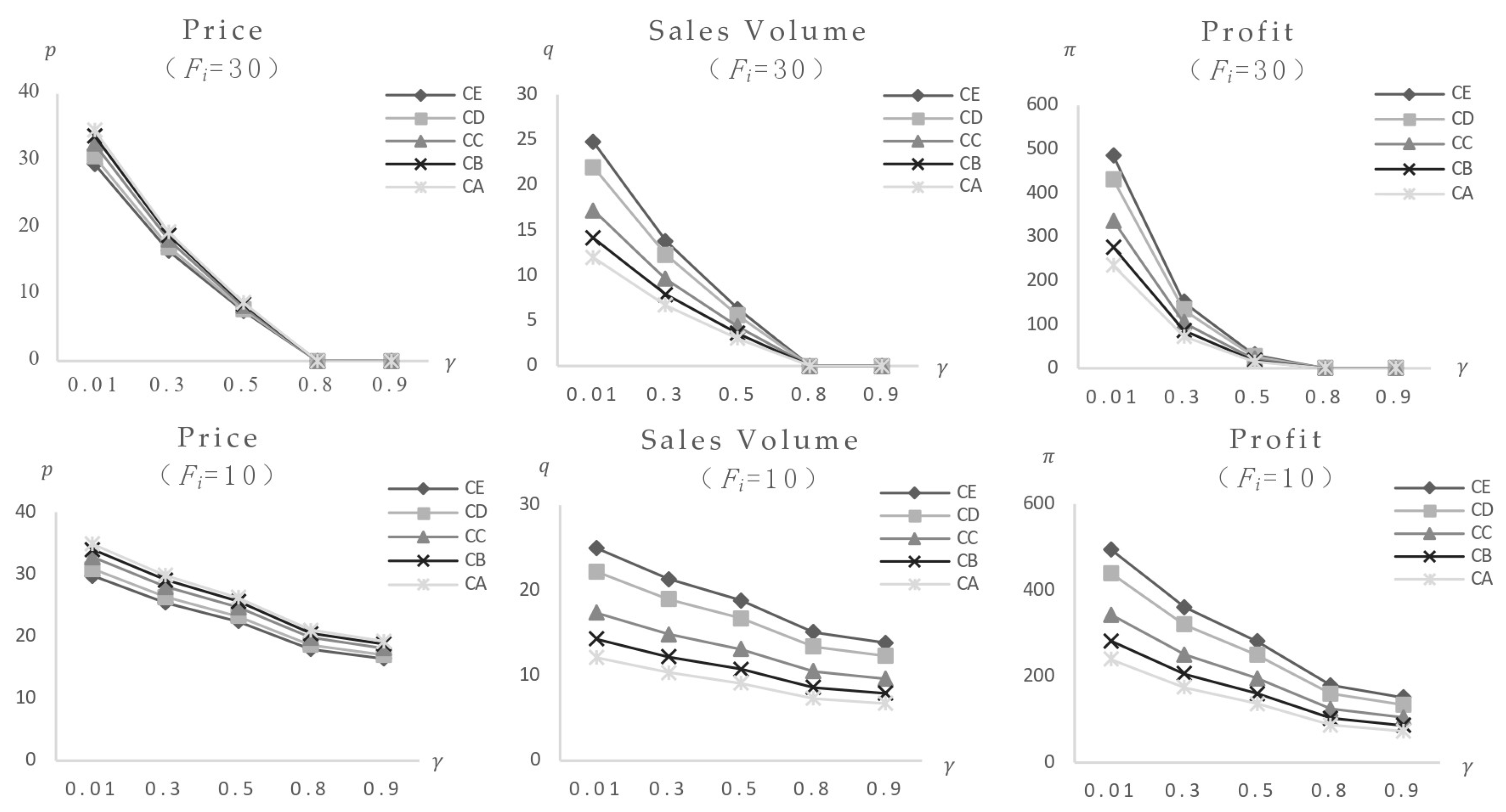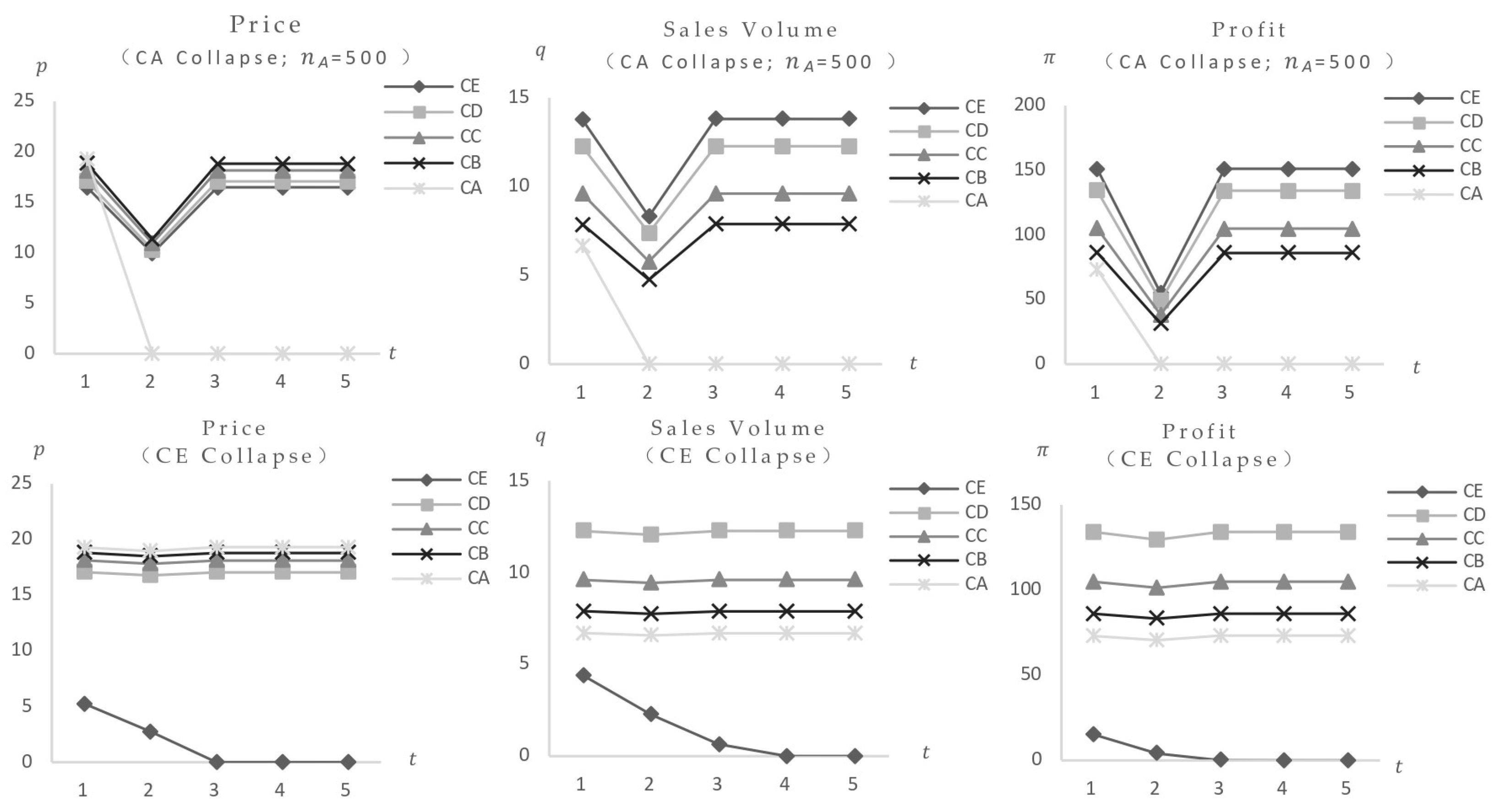Spillover Effects of Food Safety Incidents: Role of Consumers’ Heterogeneous Safety Preferences
Abstract
1. Introduction
2. Literature Review
3. Basic Model Construction
3.1. Maximizing Consumer Utility
3.2. Maximizing Enterprise Profits
3.3. Market Equilibrium
3.4. Analysis of the Impact of Sudden Food Safety Incidents on the Food Market Equilibrium
4. Impact Analysis Based on the Heterogeneity of Consumers’ Food Preferences
4.1. Analysis of the Impact of a Group of Foods at Different Safety Levels
4.2. Analysis of the Impact of a Group of the Same Security Level Foods
5. Conclusions and Implications
5.1. Research Conclusions
- Once an occurrence merely increases consumers’ safety preferences, all food incurs a negative effect. As safety preferences rise, high-risk foods are eliminated, while high-safety foods settle into a lower equilibrium than before the occurrence.
- Once an occurrence just increases consumers’ risk perceptions of specific meals, the spillover effects become more diverse. Initially, the direction of the impact is contingent upon the safety level of the product in question, as it is not all at the same safety level. Other safety-level foods will be adversely affected if the food in question is classified as a high-safety food. If the food in question is classified as a high-risk food, it will have a beneficial effect on other foods that are classified as safety-level foods. Secondly, non-involved items with the same safety level will have a higher sales volume, but lower pricing and profits. This means that consumers will increase their consumption of other brands or types of food, but because of the drop in prices, firms’ earnings will eventually suffer significant losses.
- Once an occurrence affects both risk perception and safety preferences, it causes negative market effects that are difficult to repair. Only when high-risk food is involved in an occurrence does there exist a recovery possibility.
- The market position of the relevant food (which included two dimensions: market share and safety level) influenced the intensity and duration of the incident’s impact. The larger the market share of the involved food, the greater the incident’s impact and duration. For the same market share, the higher the safety level of the involved food, the greater the impact of the incident.
- The market risk structure can also influence the magnitude and duration of the event shock. The larger the market risk, the greater the event’s impact and duration.
5.2. Policy Recommendations
5.3. Limitations and Prospects
Author Contributions
Funding
Institutional Review Board Statement
Informed Consent Statement
Data Availability Statement
Acknowledgments
Conflicts of Interest
Appendix A. Figure 2 Data Source
Appendix B. Explanations of the Measurement Units for Each Parameter
References
- Xiang, R.; Wang, M.; Lin, L.; Wu, D. A research on the crisis spillover effect of food safety incidents on competitive firms: The influence of political connections and charitable donations. Front. Public Health 2021, 9, 766385. [Google Scholar] [CrossRef] [PubMed]
- He, Z.; Zhai, G.; Suzuki, T. The immediate influence of a food safety incident on Japanese consumers’ food choice decisions and willingness to pay for safer food. Hum. Ecol. Risk Assess. Int. J. 2014, 20, 1099–1112. [Google Scholar] [CrossRef]
- Dong, X.; Li, Z. Food safety issues in China: A case study of the dairy sector. J. Sci. Food Agric. 2016, 96, 346–352. [Google Scholar] [CrossRef]
- Li, S.; Sijtsema, S.J.; Kornelis, M.; Liu, Y.; Li, S. Consumer confidence in the safety of milk and infant milk formula in China. J. Dairy Sci. 2019, 102, 8807–8818. [Google Scholar] [CrossRef] [PubMed]
- Marson, M.; Saccone, D. The effect of food price upsurges on income inequality: The richest win and the poorest lose. Food Policy 2025, 131, 102830. [Google Scholar] [CrossRef]
- Spalding, A.; Goodhue, R.E.; Kiesel, K.; Sexton, R.J. Economic impacts of food safety incidents in a modern supply chain: E. coli in the romaine lettuce industry. Am. J. Agric. Econ. 2023, 105, 597–623. [Google Scholar] [CrossRef]
- Kemsawasd, V.; Jayasena, V.; Karnpanit, W. Incidents and potential adverse health effects of serious food fraud cases originated in Asia. Foods 2023, 12, 3522. [Google Scholar] [CrossRef]
- Ha, T.M.; Shakur, S.; Pham Do, K.H. Consumer concern about food safety in Hanoi, Vietnam. Food Control 2019, 98, 238–244. [Google Scholar] [CrossRef]
- Maitiniyazi, S.; Canavari, M. Understanding Chinese consumers’ safety perceptions of dairy products: A qualitative study. Brit. Food J. 2020, 123, 1837–1852. [Google Scholar] [CrossRef]
- Tonkin, E.; Henderson, J.; Meyer, S.B.; Coveney, J.; Ward, P.R.; McCullum, D.; Webb, T.; Wilson, A.M. Expectations and everyday opportunities for building trust in the food system. Brit. Food J. 2021, 123, 702–719. [Google Scholar] [CrossRef]
- Akinwehinmi, O.; Ogundari, K.; Amos, T.T. Consumers’ food control risk perception and preference for food safety certification in emerging food markets. J. Agric. Econ. 2022, 73, 690–708. [Google Scholar] [CrossRef]
- Feng, N.; Zhang, A.; van Klinken, R.D.; Cui, L. How country image of an exporting country buffers against the impact of food safety incidents on consumer trust and purchase intention: An experimental study. Brit. Food J. 2023, 125, 4229–4246. [Google Scholar] [CrossRef]
- Vainio, A.; Kaskela, J.; Finell, E.; Ollila, S.; Lundén, J. Consumer perceptions raised by the food safety inspection report: Does the smiley communicate a food safety risk? Food Control 2020, 110, 106976. [Google Scholar] [CrossRef]
- Wang, Y.; Liu, S.; Du, J. Contagion effects vs. Competitive effects in credence goods markets: Theory and event study on China’s food markets. Econ. Res. J. 2014, 49, 141–154. [Google Scholar]
- Liu, C.; Zheng, Y. The predictors of consumer behavior in relation to organic food in the context of food safety incidents: Advancing hyper attention theory within an stimulus-organism-response model. Front. Psychol. 2019, 10, 2512. [Google Scholar] [CrossRef]
- Wen, H.; Huang, X.; Han, Q.; He, H. Trade shocks and market switching effects of food safety incidents based on media coverage. J. Agric. Econ. 2022, 131–144. [Google Scholar] [CrossRef]
- Jin, Y.; Gil, J.M. Price transmission during food safety incidents: The case of Spanish tuna fraud. Mar. Policy 2023, 156, 105794. [Google Scholar] [CrossRef]
- Li, M.; Ji, Y.; Hu, C.; Li, H. Study on regional heterogeneity of the impacts from African swine fever on meat prices in China. Chin. J. Agric. Resourc. Reg. Plann. 2022, 43, 104–114. [Google Scholar]
- Bai, L.; Li, S.; Zheng, M.; Zhang, Z.; Gong, S. Consumer brand and category switching behaviors after food safety incidents: Factors and mechanisms. Appetite 2024, 195, 107234. [Google Scholar] [CrossRef] [PubMed]
- Chen, T.; Wu, X.; Wang, B.; Yang, J. The role of behavioral decision-making in panic buying events during COVID-19: From the perspective of an evolutionary game based on prospect theory. J. Retail. Consumer Serv. 2025, 82, 104067. [Google Scholar] [CrossRef]
- Cheng, P.; Yin, Z. Risk perception, risk preference, and response of consumers to food safety crisis: The case of the clenbuterol pork. Manage. Rev. 2012, 24, 128–136, 173. [Google Scholar] [CrossRef]
- Mao, X.; Hao, C. Will food safety incidents stimulate the public’s desire for food safety governance? Foods 2024, 13, 3693. [Google Scholar] [CrossRef]
- Houser, M.; Karali, B. How scary are food scares? Evidence from animal disease outbreaks. Appl. Econ. Perspect. Policy 2020, 42, 283–306. [Google Scholar] [CrossRef]
- Lin, W.; Ma, B.; Liang, J.; Jin, S. Price response to government disclosure of food safety information in developing markets. Food Policy 2024, 123, 102602. [Google Scholar] [CrossRef]
- Shang, X.; Glynn, T. The impacts of food safety incidents on U. S. beef trade: A gravity model approach. In Proceedings of the Southern Agricultural Economics Association’s 2014 Annual Meeting, Dallas, TX, USA, 1–4 February 2014; pp. 1–20. [Google Scholar]
- Jouanjean, M.A.; Maur, J.C.; Shepherd, B. Reputation matters: Spillover effects for developing countries in the enforcement of US food safety measures. Food Policy 2015, 55, 81–91. [Google Scholar] [CrossRef]
- Shang, X.; Tonsor, G.T. Food safety recall effects across meat products and regions. Food Policy 2017, 69, 145–153. [Google Scholar] [CrossRef]
- Yang, Z.; Xiao, X.; Cheng, G. The impact of Urban household income on the consumption structure of dairy products in China. J. Agric. Econ. 2021, 121–132. [Google Scholar] [CrossRef]
- El Benni, N.; Stolz, H.; Home, R.; Kendall, H.; Kuznesof, S.; Clark, B.; Dean, M.; Brereton, P.; Frewer, L.J.; Chan, M.Y.; et al. Product attributes and consumer attitudes affecting the preferences for infant milk formula in China—A latent class approach. Food Qual. Prefer. 2019, 71, 25–33. [Google Scholar] [CrossRef]
- Chang, B. Moving beyond negative spillover: The positive consequences of an innocent brand’s responses to another brand's crisis. J. Conting. Crisis Manage. 2023, 31, 489–499. [Google Scholar] [CrossRef]
- Ferrer, R.; Perrone, H. Consumers’ costly responses to product-harm crises. Manage. Sci. 2022, 69, 2639–2671. [Google Scholar] [CrossRef]
- Chen, Y.; Hua, J.; Zhang, J. Research on the impact effect and spillover effect of pig epidemic on pork price. J. Agrotechn. Econ. 2022, 48–63. [Google Scholar] [CrossRef]
- Jin, H.J.; Kim, J.C. The effects of the BSE outbreak on the security values of US agribusiness and food processing firms. Appl. Econ. 2008, 40, 357–372. [Google Scholar] [CrossRef]
- Almaghrabi, M.A. Assessing public interest, risk perceptions, and awareness of food safety in Saudi Arabia: A cross-sectional study. Food Control 2023, 151, 109810. [Google Scholar] [CrossRef]
- Liu, R.; Gao, Z.; Snell, H.A.; Ma, H. Food safety concerns and consumer preferences for food safety attributes: Evidence from China. Food Control 2020, 112, 107157. [Google Scholar] [CrossRef]
- Macieira, A.; Teixeira, P. A case study about the perception of food safety in consumers of fresh produce from local and small farmers in the north of portugal. Biol. Life Sci. Forum 2024, 40, 3. [Google Scholar] [CrossRef]
- Yang, J.; Goddard, E. Canadian consumer responses to BSE with heterogeneous risk perceptions and risk attitudes. Canad. J. Agric. Econ. 2011, 59, 493–518. [Google Scholar] [CrossRef]
- Kashyap, P.; Suter, J.F.; McKee, S.C. Measuring changes in pork demand, welfare effects, and the role of information sources in the event of an African swine fever outbreak in the United States. Food Policy 2024, 126, 102672. [Google Scholar] [CrossRef]
- Zhang, Y.; Lu, S. Food politics in China: How strengthened accountability enhances food security. Food Policy 2024, 128, 102692. [Google Scholar] [CrossRef]
- Zheng, M.; Bai, L.; Liu, C.; Gong, S. Improving household food safety through combining nudge strategies with knowledge-based intervention: The effectiveness and mechanism. Food Control 2025, 168, 110923. [Google Scholar] [CrossRef]
- Taylor, M.; Klaiber, H.A.; Kuchler, F. Changes in U.S. consumer response to food safety recalls in the shadow of a BSE scare. Food Policy 2016, 62, 56–64. [Google Scholar] [CrossRef]
- Du, J.; Zhang, Y. Guiding policy of green food purchase behavior from the perspective of supply and demand. Soft Sci. 2023, 37, 122–130. [Google Scholar] [CrossRef]
- Daughety, A.F.; Reinganum, J.F. Imperfect competition and quality signalling. RAND J. Econ. 2008, 39, 163–183. [Google Scholar] [CrossRef]
- Zhu, S.; Li, J.; Zhang, Q.; Zhong, T. Environmental information disclosure, cost shock and firms’ adjustment to product quality. China Ind. Econ. 2022, 76–94. [Google Scholar] [CrossRef]
- Lee, Y.G.; Horeh, M.B.; Elbakidze, L. Economic evaluation of lettuce traceability systems in mitigating foodborne illness risks. Food Policy 2025, 132, 102855. [Google Scholar] [CrossRef]
- Dzwolak, W.; Anim, B. Barriers hindering maintenance of standardised HACCP-based food safety management systems in small Polish food businesses. Food Control 2025, 168, 110849. [Google Scholar] [CrossRef]
- Zamiri-Noghreh, E.; Safarzadeh, S.; Ranjbar, M. A game theoretic framework for analyzing milk supply chain safety and quality. Socio-Econ. Plann. Sci. 2025, 99, 102200. [Google Scholar] [CrossRef]
- Napel, S.; Oldehaver, G. A dynamic perspective on minimum quality standards under Cournot competition. J. Regul. Econ. 2011, 39, 29–49. [Google Scholar] [CrossRef]
- Eckel, C.; Iacovone, L.; Javorcik, B.; Neary, J.P. Multi-product firms at home and away: Cost-versus quality-based competence. J. Int. Econ. 2015, 95, 216–232. [Google Scholar] [CrossRef]
- Bureau, J.C.; Marette, S.; Schiavina, A. Non-tariff trade barriers and consumers’ information: The case of the EU-US trade dispute over beef. Eur. Rev. Agric. Econ. 1998, 25, 437–462. [Google Scholar] [CrossRef]
- Yi, L.; Tao, J.; Zhu, Z.; Tan, C.; Qi, L. Food safety incident, public health concern, and risk spillover heterogeneity: Avian influenza shocks as natural experiments in China’s consumer markets. Int. J. Environ. Res. Public Health 2019, 16, 4182. [Google Scholar] [CrossRef]
- Kuizinaitė, J.; Morkūnas, M.; Volkov, A. Assessment of the most appropriate measures for mitigation of risks in the agri-food supply chain. Sustainability 2023, 15, 9378. [Google Scholar] [CrossRef]










| Parameters | X | n | |||
|---|---|---|---|---|---|
| Numerical value | 60 | 0.9 | 0.5 | 40 | 400 |
| Food | E | D | C | B | A | |
|---|---|---|---|---|---|---|
| 80 | 60 | 30 | 10 | 0.1 | ||
| 0.8 | 1 | 1.5 | 2 | 2.5 | ||
| High-risk market | 200 | 100 | 60 | 30 | 10 | |
| Low-risk market | 10 | 50 | 200 | 100 | 40 | |
| Food | CE | CD | CC | CB | CA | |
|---|---|---|---|---|---|---|
| 30 | 30 | 30 | 30 | 30 | ||
| 0.8 | 1 | 1.5 | 2 | 2.5 | ||
| High-risk market | 200 | 100 | 60 | 30 | 10 | |
| Low-risk market | 10 | 50 | 200 | 100 | 40 | |
Disclaimer/Publisher’s Note: The statements, opinions and data contained in all publications are solely those of the individual author(s) and contributor(s) and not of MDPI and/or the editor(s). MDPI and/or the editor(s) disclaim responsibility for any injury to people or property resulting from any ideas, methods, instructions or products referred to in the content. |
© 2025 by the authors. Licensee MDPI, Basel, Switzerland. This article is an open access article distributed under the terms and conditions of the Creative Commons Attribution (CC BY) license (https://creativecommons.org/licenses/by/4.0/).
Share and Cite
Ren, F.; Fan, J. Spillover Effects of Food Safety Incidents: Role of Consumers’ Heterogeneous Safety Preferences. Foods 2025, 14, 3085. https://doi.org/10.3390/foods14173085
Ren F, Fan J. Spillover Effects of Food Safety Incidents: Role of Consumers’ Heterogeneous Safety Preferences. Foods. 2025; 14(17):3085. https://doi.org/10.3390/foods14173085
Chicago/Turabian StyleRen, Fang, and Jin Fan. 2025. "Spillover Effects of Food Safety Incidents: Role of Consumers’ Heterogeneous Safety Preferences" Foods 14, no. 17: 3085. https://doi.org/10.3390/foods14173085
APA StyleRen, F., & Fan, J. (2025). Spillover Effects of Food Safety Incidents: Role of Consumers’ Heterogeneous Safety Preferences. Foods, 14(17), 3085. https://doi.org/10.3390/foods14173085





